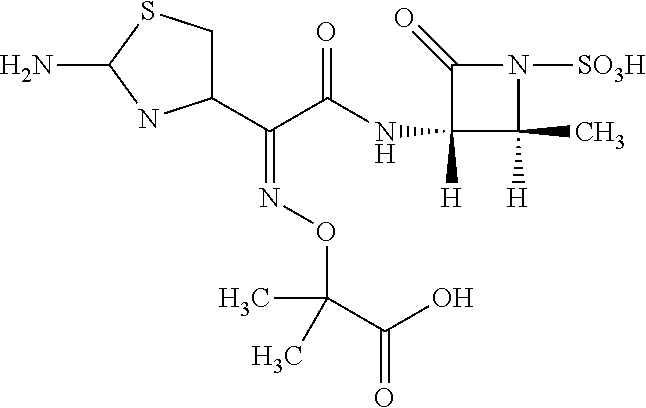Purification method of aztreonam
a technology of aztreonam and purification method, which is applied in the field of medical technology, can solve the problems of toxic and expensive agents used here, inability to recover trifluoroacetic acid, and low yield
- Summary
- Abstract
- Description
- Claims
- Application Information
AI Technical Summary
Benefits of technology
Problems solved by technology
Method used
Image
Examples
example 1
[0075]20 ml ethanol was added under stirring into 10 g of Azetronam with a purity of 95% according to U.S. Pat. No. 4,775,670 A. A 1 mol / L solution of sodium ethoxide in ethanol was added at 30° C. before heating slowly to 60° C., and then treating for 2 hs under stirring. The pH value was adjusted to 1.5 with hydrochloric acid, then cooling to room temperature to precipitate Azetronam. At this time, impurity stain was examined by TLC (developing solvent: acetonitrile:water=4:1) as 2.5%.
[0076]The solution containing Azetronam was loaded into a fixed bed filled with D201 macroporous strongly basic styrene-based anion exchange resin before the exchange proceeded until the pH value was adjusted to 5.2. Then an elution was performed using an aqueous solution of sodium hydroxide as the eluent to obtain an eluate which was collected and concentrated under reduced pressure. At this time, impurity stain was examined by TLC (developing solvent: acetonitrile:water=4:1) as 0.8%.
[0077]The pH va...
example 2
[0080]20 ml dimethyl sulfoxide was added under stirring into 10 g of Azetronam drug with a purity of 97%. A 1 mol / L solution of sodium methoxide in methanol was added at room temperature before heating slowly to 50° C., and then treating for 2.5 hs under stirring. The pH value was adjusted to 1.8 with p-fluorobenzenesulfonic acid, then cooling to room temperature to precipitate Azetronam. At this time, Impurity stain was examined by TLC (developing solvent: acetonitrile:water=4:1) as 1.5%.
[0081]The solution containing Azetronam was loaded into a fixed bed filled with D201 macroporous strongly basic styrene-based anion exchange resin before the exchange proceeded until the pH value was adjusted to 5.5. Then an elution was performed using a solution of sodium hydroxide in ethanol as the eluent to obtain an eluate which was collected and concentrated under reduced pressure. At this time, impurity stain was examined by TLC (developing solvent: acetonitrile:water=4:1) as 0.7%.
[0082]The p...
example 3
[0085]20 ml tetrohydronfuran was added under stirring into 10 g of crude Azetronam with a purity of 96% according to CN 1681812 A. A 1 mol / L solution of potassium ethoxide in ethanol was added at 40° C. before heating slowly to 65° C., and then treating for 1 h under stirring. The pH value was adjusted to 2.0 with formic acid, then cooling to room temperature to precipitate Azetronam. At this time, Impurity stain was examined by TLC (developing solvent: acetonitrile:water=4:1) as 2.0%.
[0086]The solution containing Azetronam was loaded into a reaction tank filled with Amberlite® IRA-900 anion exchange resin and the exchange was accelerated by introducing CO2 until the pH value was adjusted to 5.8. Then an elution was performed using a solution of potassium hydroxide in ethanol as the eluent to obtain an eluate which was collected and concentrated under reduced pressure. At this time, Impurity stain was examined by TLC (developing solvent: acetonitrile:water=4:1) as 0.8%.
[0087]The pH ...
PUM
| Property | Measurement | Unit |
|---|---|---|
| temperature | aaaaa | aaaaa |
| temperature | aaaaa | aaaaa |
| temperature | aaaaa | aaaaa |
Abstract
Description
Claims
Application Information
 Login to View More
Login to View More - R&D
- Intellectual Property
- Life Sciences
- Materials
- Tech Scout
- Unparalleled Data Quality
- Higher Quality Content
- 60% Fewer Hallucinations
Browse by: Latest US Patents, China's latest patents, Technical Efficacy Thesaurus, Application Domain, Technology Topic, Popular Technical Reports.
© 2025 PatSnap. All rights reserved.Legal|Privacy policy|Modern Slavery Act Transparency Statement|Sitemap|About US| Contact US: help@patsnap.com

